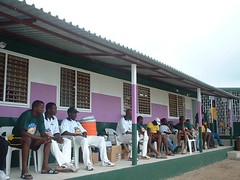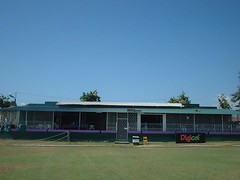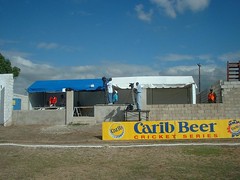
Kensington Park - Top of the Class
from MICHELLE McDONALD in JamaicaIf the standard of a first-class cricket ground is determined solely by the quality of its pitch, then Kensington Park in Jamaica has shot to the top of the class.
Hosting its inaugural first-class match during the fourth round of the 2005 Carib Beer series, the 'oohs' and 'aahs' from those in the know would have thoroughly pleased the club's management committee who toiled to make the match a reality despite the odds.
In the 125 years of its existence, Kensington Cricket Club has had a few homes. It was first moved from its original location at Camperdown Kingston 8. This occurred when Cosmo Lorenzo Dicks was appointed captain in 1881 and relocated the club, first known as 'St Andrew Juniors', to the property he owned at Sligoville in St Catherine known as 'Kensington'. Not unexpectedly, he changed the club's name to Kensington Cricket Club. The move to the present location at Preston Road in Kingston 2 occurred in 1901 after a nine year stay at Winchester Park located near to Sabina Park.
Kensington Park has a rich history, including being virtually the headquarters of Jamaica Cricket as the Cricket Council held all their meetings, committee and otherwise, there. According to a vignette written in 1985 as part of centennial celebrations, the ground achieved a number of firsts in Jamaica's sporting history. In 1901, it introduced the Tea Break to Jamaican cricket against St Catherine Cricket Club; in 1906 it organized the first ever track and field meet in Jamaica; and in 1911, it organized the first Jamaican cycle racing meet which continued for over 25 years.
Not without its share of battering from the elements, in 1951 all the buildings were destroyed by a hurricane and in 1979 fire destroyed the club house. The recent devastating Hurricane Ivan did major damage to the roof of the club house.
Kensington now stands tall and during the fourth round match between Jamaica and Guyana, spectators who had been to the ground prior to this year were able to see a number of improvements on their return for this match. A representative of the 14-man Management Committee detailed these improvements:

* Conversion of two 40 feet containers into a single dressing room with an area for physical therapy, umpires and a small storage area.
* Construction of an area to accommodate the media.
* Painting of the entire facility.
* Refurbishing of the existing dressing rooms.
* Re-roofing of the club house.
According to the representative, the size of the changing room facilities clearly was a problem. "Previously, we hosted a one-day game but for a first-class game, it was felt that the players needed to be more comfortable." When the club was included in the provisional fixtures for this year's series pending significant improvements, that was the impetus to find the approximately J$1.2 million (US$19,670) it would take to bring plans to fruition ? plans that were on the drawing board for a number of years.
We have heard local clubs lamenting about their dire financial situation. Where would the money come from? Fortunately, the club was able to convince a few sponsors, most importantly Digicel, who are the new sponsors of West Indies cricket. The Digicel branding was very prominent around the ground, incomplete as it was for the match. Permanent signs will be mounted later.

Why the push to be awarded First Class status now? "Because of the extended Carib Beer home series with five home games, and the unavailability of Sabina Park due to the repairs being done before the 2005 home international series, we felt there was a real opportunity," said the club's representative. In addition, since Sabina Park is due to be closed for extensive physical work, it would also be unavailable in 2006.
The upcoming World Cup was also a consideration. "We feel this is a major opportunity. We have always had the best wicket in Jamaica, including Sabina Park, and certainly this game is a testament to that fact," said the representative. The club is hoping to be considered for practice sessions and warm up games.
The pitch is Kensington's crowning glory. Who has been responsible for its preparation? Noel Johnson is the man in charge of the grounds, including the pitch. Ralph Hinckson, who is the coach of Kensington, assists the groundsmen who work on the pitch, having learnt the art from a 'Mr Murphy' in the 1960's. He has passed on his knowledge to Roy DaCosta who has been the Head Groundsman from 1990.
DaCosta described the preparation that started three days before the Thursday start date of the match. "First we flood it out with water for two days, then on the third day we wet it and roll it with grass on it, then cut the grass," said DaCosta. He described it as an "even pitch with a little more bounce at the southern end due to more grass." DaCosta is able to give dedicated attention to the grounds as he lives on the property. Work is year round for him because the ground is used to host school, Business House and domestic cricket.

The lush, well-grassed outfield that DaCosta and his seven-man team have produced was also a talking point during the match. By comparison, just next door at another club ground, sparse grassy patches can be seen. Many brown patches covered the rest of the outfield. That is a consequence, among other things, of the club trying to improve its financial position by renting it out for sports other than cricket. But at Kensington, Hinckson says that the club took a decision in the 1970's to discontinue the playing of football there.
And the decision has paid off with a pitch that stood up for the four day match and from all reports, could have been used for another five days. "You have to make a choice to try and have a better facility. The quality of the game is affected by the kind of wicket. You can't play shots if wickets are low," said the club's representative.
Many of Kensington's players have gone on to represent Jamaica and the West Indies. The most notable of these were perhaps George Headley, Frank Worrell and Lawrence Rowe, and others included JK Holt Jnr, Alf Valentine, Basil Williams, Desmond Lewis, Uton Dowe, Patrick Patterson, current Jamaica coach Robert Haynes, the late Laurie Williams, Daren Powell, David Bernard Jr and Wavell Hinds.
For the spectators who turned up to see the lopsided affair between Jamaica and Guyana, the improvements to the club were welcomed. Steve, a police officer who visits the ground regularly said "They've done a fantastic job. The organization is very good. In terms of the grounds, the ground staff did a fantastic job. This is good for first-class cricket. I wish other clubs in Jamaica would do such a good job. The ground is spectator-friendly, there is no parking difficulty and there are security personnel in place."

Although the entry price was a bargain at J$200 per day (US$3.30), the turnout was disappointing. This is a general problem with First Class matches around the region, with or without the West Indies players present, and the West Indies Cricket Board and territorial associations will have to be more innovative in their efforts to attract spectators. Clubs such as Kensington which go to great lengths to finance improvements want to maximize their profits.
For hosting a game, clubs can receive as much as J$500,000 (US$8,200.00). Match day game costs for the club includes lunch for players and officials, the press area, seating and general comfort of the spectators such as tents and portable toilets. The club hopes to gain profit from, among other things, the sale of drinks and concessionaire fees.
Neville, who has been a club member for about two years, had this to say. "The setting is great. People seem to be enjoying themselves. I'm most pleased about the pitch and there are excellent conditions out there. The general improvements have been good and I'm sure we'll get more first-class matches. I'm sure there'll be more improvements."
More work is on the cards. Paramount on the list is better press facilities. For this match, both the broadcast and print media were in the same location, which is not an ideal arrangement. In addition, there were two camera crews which limited the view of journalists. Initial thoughts are to again convert containers. Permanent seating will be erected and the wall which separates the original two dressing rooms will be knocked out and the two made into one. In addition, the managing committee member said "we've had some ambitious plans to build a basketball and netball court to attract membership. Community participation is very low."
In earlier days, most of the membership came from the surrounding area. "Membership is a struggle," lamented the representative. "In the very recent past, membership was middle class; most drove a car. Today many are school boys. They are subsidized with things such as bus fare, meals, and accommodation for those who come from St Catherine and as far as St Elizabeth on a weekend."
Kensington has performed well during the domestic competition over the years. From 1961 to 1965, the club created history to become the first and only club to win the Senior Cup Cricket Competition (now the Super Cup) for five consecutive years, this under the captaincy of JK Holt Jnr. Last year they won the Super Cup and were beaten finalists in the limited overs competition under the captaincy of Wavell Hinds.
With those continuing encouraging results, the club is soldering on despite financial limitations. Apart from the lack of membership and therefore reduced revenue from dues, the club's structure does not allow it to seek funds from the Jamaica Social Investment Fund or the Sports Development Foundation. "We are a members' club, therefore it has to be private investment," said the committee member.
Kensington Cricket Club is keen to attract the sponsorship necessary to lift the plans from the drawing board. "Clearly if we have a superb ground then we expect to be able to charge more for the use of our facilities," said the representative. In the meantime, the managing committee is deserving of a pat on the back for a job well done.
Success for Kensington is good news for Jamaica and ultimately West Indies cricket.
* EDITOR'S NOTE: All material on this website, including this article, are protected by copyright laws, and may not be reproduced, republished, distributed, transmitted, displayed, broadcast or otherwise exploited in any manner without the express prior written permission of CaribbeanCricket.com.